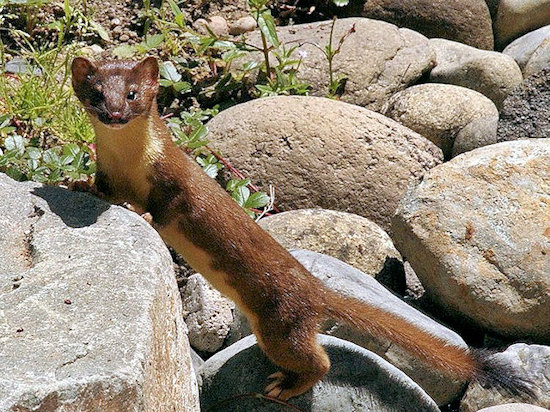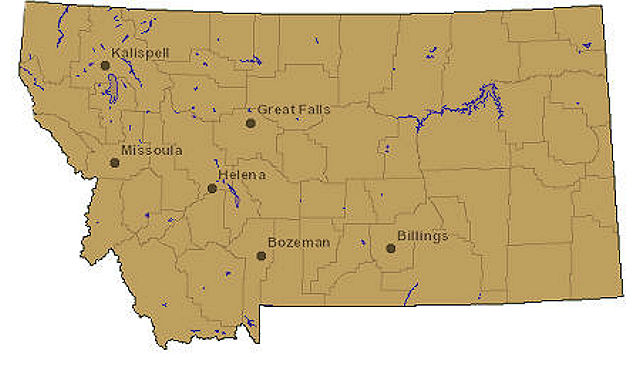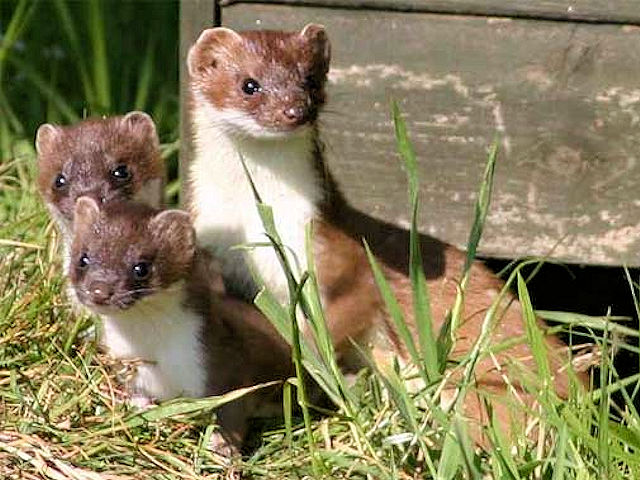Long Tailed Weasel

Mustela frenata
Order:
Carnivora
Family:
Mustelidae
Status: Fur of some value, unprotected predator.
Identifying Characteristics: Largest and most widely distributed of the three North American weasels. Distinguished by its long, slender body and long neck. Longest tail of the North American weasels. During summer fur rich brown on the back and sides with yellowish-white under parts, black tip on tail, and no whitish line down inside of leg. Acquires a white winter coat. Adult males noticeably larger than females.
Total length: 11 to 16.5 inches. Weights: 3 to 12 ounces.
Habitat: Found in almost all land habitats near water. Has the broadest ecological and geographical range of the North American weasels. Prefers areas with abundant prey. Avoids dense forest, most abundant in late seral ecotones.
Food Habits: More of a generalist than the short-tailed and least weasels. Feeds mostly on small mammals up to rabbit-sized, but eats birds and other animals as well.
Life History: Primarily nocturnal, but sometimes active during the day. Quite fearless and curious. Mainly terrestrial but can climb and swim well. Nests in old burrows of other animals. Mates during summer; 205 to 337 day gestation; delayed implantation; young born during April; litter size 4 to 9.
Similar Species: Short-tail weasel - white line down inside of leg, smaller. Least weasel - no black tip on tail, smaller. Mink - nearly uniform dark brown. Marten - heavier, much larger.
 Characteristics
Characteristics
The long-tailed weasel, which is the largest of
the three weasels found in Montana and varies
from 13 to 18 inches in length, including a 6
1/2 inch tail. It is the long tail which
gives it its name. They are about 2 to 3 1/2
inches high and weigh up to 12 ounces.
It has a long, slender, muscular body with short legs. The head is small, with beady eyes, small ears and a pointed nose. They move with quick movements and a graceful, bounding gait. All three weasels change color with the seasons, and there is no color difference between the sexes. All the senses are well developed in the weasel.
The long tailed weasel is much the same in color as the short tailed weasel except that, in some areas, it does not become white in winter. The feet are dark brown in summer whereas the short tailed weasel has pale yellowish feet in summer. The tail has a black tip throughout the year. The molting pattern is different than in short tailed weasels, starting on the back in spring and causing a brindled appearance to the facial markings.
Life Cycle
The long-tailed weasel females mature at 3 to 4
months and males mature at about one year. The
breeding season is in July. There is a period of
delayed implantation with a gestation period of
9 to 10 months. The period of active pregnancy
is 23 to 17 days.
Litter sizes varies from four to thirteen, with an average of six to eight. The young are born in April or May in nests constructed in underground dens or hay piles. Mouse nests and burrows are often used and heavily lined with fine grass and mouse fur. The male begins to bring food to the den about 1 month after the young are born. The young are weaned at the end of 5 weeks and are able to hunt for themselves by 7 or 8 weeks of age. The family stays together until late summer and then disperses. The life expectancy of weasels is short, probably less than a year, although they are capable of living as long as 6 years.
Food
Weasels prey on small rodents such as mice,
rats, voles, hares, rabbits, and chipmunks. They
also take shrews, birds, birds eggs, frogs,
bats, insects, earthworms and may occasionally
kill domestic chickens.
The weasel hunts by tirelessly and persistently investigating every small hole, crevice, bush or rock pile it encounters. They will track prey by following their scent trails and generally attack prey by ambushing and pouncing on it. They are very quick and kill by piercing the base of the skull with their teeth. The weasel frequently kills more than it can eat and often caches leftover food. The weasel can consume up to one third of its own weight in a 24 hour period.
 Habits
Habits
Weasels are curious, alert and bold. They are
persistent hunters who seldom remain long in
their dens and may be abroad hunting at any
hour, although they are usually most active at
night. Weasels are active year round. Weasels
occasionally hunt in pairs but, for the most
part, are solitary except during breeding and
rearing season. They are good swimmers and can
also climb trees. All species emit a strong musk
odor when alarmed, and the weasel may stamp its
feet when annoyed. Weasels may mark their trails
with droppings. Home ranges very from 30 to 400
acres.
Population
Weasel populations often cycle with mouse
populations. Several parasites can infect
weasels, such as guinea worm and kidney worms.
These probably have little impact on the
population.
Weasels are subject to predation from hawks, owls, foxes, coyotes, dogs, cats and man.
In agricultural areas, weasels are more common due to the practice of storing grain which provides ideal conditions for mice.
Habitat
Weasels prefer woodlands or open country with
hedgerows, thickets or fence rows. They are
usually found near water but are not
semi-aquatic as is the mink. They frequent stone
piles, brush heaps, wood piles, hay stacks, log
piles and old abandoned buildings.
The long-tailed weasel is found in almost all land habitats near water. It has the broadest ecological and geographical range of the North American weasel. It avoids dense forests.
The dens of weasels are shallow chambers about 6 inches underground with two to three entrances and are lined with mouse fur and grass.
Economic Value
The fur of the long-tailed weasel commands a
higher price because it is so much larger.
Weasels play an important role in helping to control rodent populations.